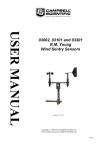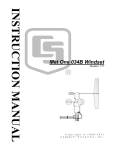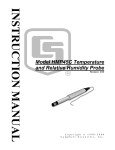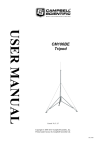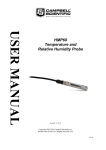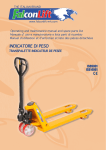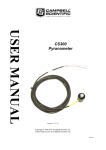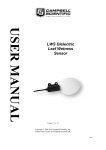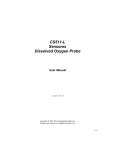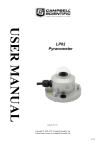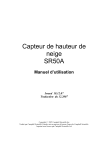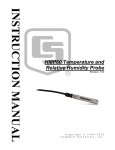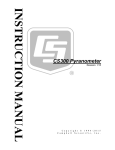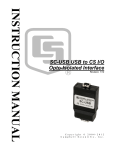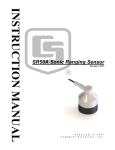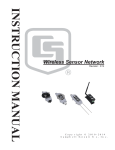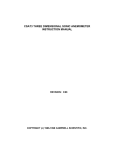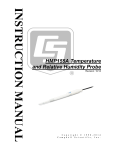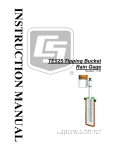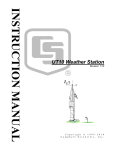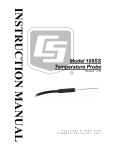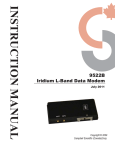Download Campbell Met One 034A-L Instruction manual
Transcript
INSTRUCTION MANUAL Met One 034B Wind Set Revision: 9/14 C o p y r i g h t © 1 9 8 0 - 2 0 1 4 C a m p b e l l S c i e n t i f i c , I n c . Limited Warranty “Products manufactured by CSI are warranted by CSI to be free from defects in materials and workmanship under normal use and service for twelve months from the date of shipment unless otherwise specified in the corresponding product manual. (Product manuals are available for review online at www.campbellsci.com.) Products not manufactured by CSI, but that are resold by CSI, are warranted only to the limits extended by the original manufacturer. Batteries, fine-wire thermocouples, desiccant, and other consumables have no warranty. CSI’s obligation under this warranty is limited to repairing or replacing (at CSI’s option) defective Products, which shall be the sole and exclusive remedy under this warranty. The Customer assumes all costs of removing, reinstalling, and shipping defective Products to CSI. CSI will return such Products by surface carrier prepaid within the continental United States of America. To all other locations, CSI will return such Products best way CIP (port of entry) per Incoterms ® 2010. This warranty shall not apply to any Products which have been subjected to modification, misuse, neglect, improper service, accidents of nature, or shipping damage. This warranty is in lieu of all other warranties, expressed or implied. The warranty for installation services performed by CSI such as programming to customer specifications, electrical connections to Products manufactured by CSI, and Product specific training, is part of CSI's product warranty. CSI EXPRESSLY DISCLAIMS AND EXCLUDES ANY IMPLIED WARRANTIES OF MERCHANTABILITY OR FITNESS FOR A PARTICULAR PURPOSE. CSI hereby disclaims, to the fullest extent allowed by applicable law, any and all warranties and conditions with respect to the Products, whether express, implied or statutory, other than those expressly provided herein.” Assistance Products may not be returned without prior authorization. The following contact information is for US and international customers residing in countries served by Campbell Scientific, Inc. directly. Affiliate companies handle repairs for customers within their territories. Please visit www.campbellsci.com to determine which Campbell Scientific company serves your country. To obtain a Returned Materials Authorization (RMA), contact CAMPBELL SCIENTIFIC, INC., phone (435) 227-9000. After an application engineer determines the nature of the problem, an RMA number will be issued. Please write this number clearly on the outside of the shipping container. Campbell Scientific’s shipping address is: CAMPBELL SCIENTIFIC, INC. RMA#_____ 815 West 1800 North Logan, Utah 84321-1784 For all returns, the customer must fill out a “Statement of Product Cleanliness and Decontamination” form and comply with the requirements specified in it. The form is available from our web site at www.campbellsci.com/repair. A completed form must be either emailed to [email protected] or faxed to (435) 227-9106. Campbell Scientific is unable to process any returns until we receive this form. If the form is not received within three days of product receipt or is incomplete, the product will be returned to the customer at the customer’s expense. Campbell Scientific reserves the right to refuse service on products that were exposed to contaminants that may cause health or safety concerns for our employees. Precautions DANGER — MANY HAZARDS ARE ASSOCIATED WITH INSTALLING, USING, MAINTAINING, AND WORKING ON OR AROUND TRIPODS, TOWERS, AND ANY ATTACHMENTS TO TRIPODS AND TOWERS SUCH AS SENSORS, CROSSARMS, ENCLOSURES, ANTENNAS, ETC. FAILURE TO PROPERLY AND COMPLETELY ASSEMBLE, INSTALL, OPERATE, USE, AND MAINTAIN TRIPODS, TOWERS, AND ATTACHMENTS, AND FAILURE TO HEED WARNINGS, INCREASES THE RISK OF DEATH, ACCIDENT, SERIOUS INJURY, PROPERTY DAMAGE, AND PRODUCT FAILURE. TAKE ALL REASONABLE PRECAUTIONS TO AVOID THESE HAZARDS. CHECK WITH YOUR ORGANIZATION'S SAFETY COORDINATOR (OR POLICY) FOR PROCEDURES AND REQUIRED PROTECTIVE EQUIPMENT PRIOR TO PERFORMING ANY WORK. Use tripods, towers, and attachments to tripods and towers only for purposes for which they are designed. Do not exceed design limits. Be familiar and comply with all instructions provided in product manuals. Manuals are available at www.campbellsci.com or by telephoning (435) 227-9000 (USA). You are responsible for conformance with governing codes and regulations, including safety regulations, and the integrity and location of structures or land to which towers, tripods, and any attachments are attached. Installation sites should be evaluated and approved by a qualified engineer. If questions or concerns arise regarding installation, use, or maintenance of tripods, towers, attachments, or electrical connections, consult with a licensed and qualified engineer or electrician. General • Prior to performing site or installation work, obtain required approvals and permits. Comply with all governing structure-height regulations, such as those of the FAA in the USA. • Use only qualified personnel for installation, use, and maintenance of tripods and towers, and any attachments to tripods and towers. The use of licensed and qualified contractors is highly recommended. • Read all applicable instructions carefully and understand procedures thoroughly before beginning work. • Wear a hardhat and eye protection, and take other appropriate safety precautions while working on or around tripods and towers. • Do not climb tripods or towers at any time, and prohibit climbing by other persons. Take reasonable precautions to secure tripod and tower sites from trespassers. • Use only manufacturer recommended parts, materials, and tools. Utility and Electrical • You can be killed or sustain serious bodily injury if the tripod, tower, or attachments you are installing, constructing, using, or maintaining, or a tool, stake, or anchor, come in contact with overhead or underground utility lines. • Maintain a distance of at least one-and-one-half times structure height, 20 feet, or the distance required by applicable law, whichever is greater, between overhead utility lines and the structure (tripod, tower, attachments, or tools). • Prior to performing site or installation work, inform all utility companies and have all underground utilities marked. • Comply with all electrical codes. Electrical equipment and related grounding devices should be installed by a licensed and qualified electrician. Elevated Work and Weather • Exercise extreme caution when performing elevated work. • Use appropriate equipment and safety practices. • During installation and maintenance, keep tower and tripod sites clear of un-trained or nonessential personnel. Take precautions to prevent elevated tools and objects from dropping. • Do not perform any work in inclement weather, including wind, rain, snow, lightning, etc. Maintenance • Periodically (at least yearly) check for wear and damage, including corrosion, stress cracks, frayed cables, loose cable clamps, cable tightness, etc. and take necessary corrective actions. • Periodically (at least yearly) check electrical ground connections. WHILE EVERY ATTEMPT IS MADE TO EMBODY THE HIGHEST DEGREE OF SAFETY IN ALL CAMPBELL SCIENTIFIC PRODUCTS, THE CUSTOMER ASSUMES ALL RISK FROM ANY INJURY RESULTING FROM IMPROPER INSTALLATION, USE, OR MAINTENANCE OF TRIPODS, TOWERS, OR ATTACHMENTS TO TRIPODS AND TOWERS SUCH AS SENSORS, CROSSARMS, ENCLOSURES, ANTENNAS, ETC. Table of Contents PDF viewers: These page numbers refer to the printed version of this document. Use the PDF reader bookmarks tab for links to specific sections. 1. Introduction ................................................................. 1 2. Cautionary Statements ............................................... 1 3. Initial Inspection ......................................................... 1 3.1 Ships With List .................................................................................... 2 4. Quickstart .................................................................... 2 4.1 4.2 Step 1—Mount the Sensor ................................................................... 2 Step 2—Use Short Cut to Program Datalogger and Generate Wiring Diagram ................................................................................ 4 5. Overview ...................................................................... 7 6. Specifications ............................................................. 7 6.1 6.2 6.3 Wind Speed .......................................................................................... 8 Wind Direction..................................................................................... 8 General Specifications ......................................................................... 8 7. Installation ................................................................... 8 7.1 7.2 7.3 7.4 Siting .................................................................................................... 8 Mounting Options ................................................................................ 9 Wiring .................................................................................................. 9 Programming...................................................................................... 10 7.4.1 Wind Speed ................................................................................. 10 7.4.2 Wind Direction ........................................................................... 11 7.4.3 Wind Vector Processing Instruction ........................................... 11 7.4.4 Long Lead Lengths ..................................................................... 12 8. Sensor Maintenance ................................................. 12 9. Troubleshooting........................................................ 12 9.1 9.2 Wind Direction................................................................................... 12 Wind Speed ........................................................................................ 13 10. References ................................................................ 13 Appendices A. Importing Short Cut Code ...................................... A-1 A.1 Importing Short Cut Code into a Program Editor ........................... A-1 i Table of Contents B. Example Program.................................................... B-1 C. Wind Direction Sensor Orientation ....................... C-1 C.1 Determining True North and Sensor Orientation ............................ C-1 D. Wind Direction Measurement Theory.................... D-1 Figures 4-1. D-1. 034B mounted on a crossarm using a 17953 NU-RAIL crossover fitting................................................................................................ 3 CM200 Series Crossarm with CM220 Right Angle Mounting Bracket ............................................................................................. 4 CM216 mount ..................................................................................... 9 Magnetic declination for the contiguous United States (2004) ....... C-2 Declination angles east of True North are subtracted from 0 to get True North .............................................................................. C-3 Declination angles west of True North are added to 0 to get True North ................................................................................... C-3 034B potentiometer in a half bridge circuit ..................................... D-1 5-1. 7-1. 7-2. 7-3. B-1. Recommended Cable Lengths ............................................................. 7 Connections to Campbell Scientific Dataloggers ................................ 9 Wind Speed Multiplier* .................................................................... 11 Parameters for Wind Direction.......................................................... 11 Wiring for Example Program .......................................................... B-1 4-2. 7-1. C-1. C-2. C-3. Tables ii Met One 034B Wind Set 1. Introduction The 034B Wind Set combines a 3-cup anemometer and vane into a single integrated package to measure wind speed and direction. It is cabled for use with our dataloggers, and can provide measurements for a variety of applications. NOTE 2. 3. This manual provides information only for CRBasic dataloggers. It is also compatible with most of our retired Edlog dataloggers. For Edlog datalogger support, see an older manual at www.campbellsci.com/old-manuals or contact a Campbell Scientific application engineer for assistance. Cautionary Statements • READ AND UNDERSTAND the Precautions section at the front of this manual. • The 034B is a precision instrument. Please handle it with care. • If the 034B is to be installed at heights over 6 feet, be familiar with tower safety and follow safe tower climbing procedures. • Danger—Use extreme care when working near overhead electrical wires. Check for overhead wires before mounting the 034B or before raising a tower. • The set screw holes must be covered with labels to prevent corrosion and assure the warranty. • The black outer jacket of the cable is Santoprene® rubber. This compound was chosen for its resistance to temperature extremes, moisture, and UV degradation. However, this jacket will support combustion in air. It is rated as slow burning when tested according to U.L. 94 H.B. and will pass FMVSS302. Local fire codes may preclude its use inside buildings. Initial Inspection Upon receipt of the 034B, inspect the packaging and contents for damage. File damage claims with the shipping company. Immediately check package contents against the shipping documentation (see Section 3.1, Ships With List). Contact Campbell Scientific about any discrepancies. The model number and cable length are printed on a label at the connection end of the cable. Check this information against the shipping documents to ensure the expected product and cable length are received. 1 Met One 034B Wind Set 3.1 Ships With List The 034B Wind Set ships with: (1) 1/16-inch Allen wrench (1) Bushing from Met One (1) Calibration Sheet (3) Direction hub stickers (1) ResourceDVD (1) Wind Vane (1) Sensor cable of user-specified length 4. Quickstart 4.1 Step 1—Mount the Sensor Tools required: • • • • • • • 1/2-inch open-end wrench (for CM220) 5/64-inch and 1/16-inch Allen wrenches compass and declination angle for the site (see Appendix C) small screw driver provided with datalogger UV resistant cable ties small pair of diagonal-cutting pliers 6-inch to 10-inch torpedo level This quick start installs the 034B using: • • 17953, 1 x 1 inch NU-RAIL Crossover Fitting (FIGURE 4-1), or CM220, Right-Angle Mounting Kit (FIGURE 4-2) Please review Section 7, Installation, for siting and other guidelines. CAUTION 2 1. Fully insert vane arm into hub (see FIGURE 4-1). 2. Align vane with center axis of sensor (see FIGURE 4-1). 3. Using the Allen wrench, tighten set screws at the top of the hub (see FIGURE 4-1). 4. Cover the set screw hole with one of the small round stickers included with the 034B. One of these labels is already installed on the hub covering the set screw that attaches the hub to the sensor. Extra labels are included with the 034B to recover the holes if the sensor has to be disassembled for maintenance. The set screw holes must be covered with the labels to prevent corrosion and assure the warranty. 5. Mount a CM200-series crossarm to the tripod or tower. 6. Orient the crossarm North-South, with the CM220 mount or 17953 NURAIL on the North end. Appendix C contains detailed information on Met One 034B Wind Set determining True North using a compass and the magnetic declination for the site. 7. Remove the alignment screw at the base of the 034B (FIGURE 4-1). 8. Insert the 034B into the aluminum bushing provided with the sensor (see FIGURE 4-1). 9. Align the hole in the bushing with that in the 034B base and replace the screw (see FIGURE 4-1). 10. Insert the 034B/bushing into the NU-RAIL fitting (FIGURE 4-1) or the CM220’s U-bolt (FIGURE 4-2). 11. Align the sensor so that the counter weight points to true South and tighten the set screws on the NU-RAIL or U-bolts on the CM220. Final sensor orientation is done after the datalogger has been programmed to measure wind direction as described in Appendix C. 12. Remove the shoulder screw to allow the vane to rotate (see FIGURE 4-1). 13. Attach the sensor cable to the six pin male connector on the 034B. Make sure the connector is properly keyed. Finger tighten the knurled ring. 14. Route the sensor cable along the underside of the crossarm to the tripod or tower, and to the instrument enclosure. 15. Secure the cable to the crossarm and tripod or tower using cable ties. FIGURE 4-1. 034B mounted on a crossarm using a 17953 NU-RAIL crossover fitting 3 Met One 034B Wind Set CM220 CM200 Series Crossarm FIGURE 4-2. CM200 Series Crossarm with CM220 Right Angle Mounting Bracket 4.2 Step 2—Use Short Cut to Program Datalogger and Generate Wiring Diagram Short Cut is an easy way to program the datalogger to measure the 034B and assign terminals. The following procedure shows using Short Cut to program the 034B. 4 1. Install Short Cut by clicking on the install file icon. Get the install file from either www.campbellsci.com, the ResourceDVD, or find it in installations of LoggerNet, PC200W, PC400, or RTDAQ software. 2. The Short Cut installation should place a Short Cut icon on the desktop of your computer. To open Short Cut, click on this icon. Met One 034B Wind Set 3. When Short Cut opens, select New Program. 4. Select Datalogger Model and Scan Interval (default of 5 seconds is OK for most applications). Click Next. 5 Met One 034B Wind Set 5. Under the Available Sensors and Devices list, select the Sensors | Meteorological | Wind Speed & Direction folder. Select 034A/034B Wind Speed & Direction Sensor. Click to move the selection to the Selected device window. The wind speed defaults to meters/second. This can be changed by clicking the Wind Speed box and selecting one of the other options. 6 6. After selecting the sensor, click at the left of the screen on Wiring Diagram to see how the sensor is to be wired to the datalogger. The wiring diagram can be printed out now or after more sensors are added. 7. Select any other sensors you have, then finish the remaining Short Cut steps to complete the program. The remaining steps are outlined in Short Cut Help, which is accessed by clicking on Help | Contents | Programming Steps. Met One 034B Wind Set 5. 8. If LoggerNet, PC400, RTDAQ, or PC200W is running on your PC, and the PC to datalogger connection is active, you can click Finish in Short Cut and you will be prompted to send the program just created to the datalogger. 9. If the sensor is connected to the datalogger, as shown in the wiring diagram in step 6, check the output of the sensor in the datalogger support software data display to make sure it is making reasonable measurements. Overview The 034B, Wind Set is used to measure horizontal wind speed and direction. Wind speed is measured with a three cup anemometer. Rotation of the cup wheel opens and closes a reed switch at a rate proportional to wind speed. Vane position is transmitted by a 10 kΩ potentiometer. With a precision excitation voltage applied, the output voltage is proportional to wind direction. The accompanying Met One manual contains additional information on the operating principals, installation, and maintenance of the sensor. The Met One manual is also available at their website (www.metone.com). Cable length for the 034B is specified when the sensor is ordered. TABLE 5-1 gives the recommended cable length for mounting the sensor at the top of the tripod/tower with a CM202 crossarm. TABLE 5-1. Recommended Cable Lengths CM106 CM110 CM115 CM120 UT10 UT20 UT30 11 ft 14 ft 19 ft 24 ft 14 ft 24 ft 37 ft The 034B’s cable can terminate in: • • • 6. Pigtails that connect directly to a Campbell Scientific datalogger (option –PT). Connector that attaches to a prewired enclosure (option –PW). Refer to www.campbellsci.com/prewired-enclosures for more information. Connector that attaches to a CWS900, Wireless Sensor Interface (option –CWS). The CWS900 allows the 034B to be used in a wireless sensor network. Refer to www.campbellsci.com/cws900 for more information. Specifications Features: • Designed for continuous, long term, unattended operation in adverse conditions • Constructed of light-weight aluminum • Compatible with Campbell Scientific CRBasic dataloggers: CR6, CR200(X) series, CR800 series, CR1000, CR3000, CR5000, and CR9000X 7 Met One 034B Wind Set 6.1 6.2 6.3 7. Wind Speed Operating Range: 0 to 75 m s–1 (0 to 167 mph) Threshold: 0.4 m s–1 (0.9 mph) Accuracy: ±0.12 m s–1 (±0.25 mph) for wind speed < 10.1 m s–1 (22.7 mph) ±1.1% of reading for wind speeds > 10.1 m s–1 (22.7 mph) Output Signal: contact closure (reed switch) Resolution: (1.789 mph) / (scan rate in seconds) or (0.7998 m s–1) / (scan rate in seconds) Anemometer Height: 24.4 cm (9.6 in) Anemometer Radius: 10.7 cm (4.2 in) Wind Direction Length: 11.4 cm (4.5 in) Measurement Range: 0 to 360° Threshold: 0.4 m s–1 (0.9 mph) Accuracy: ±4° Resolution: 0.5° Potentiometer Resistance: 0 to 10 kΩ open at crossover General Specifications Operating Temperature Range: –30 to +70 °C Weight: 907 g (2.0 lb) Installation If you are programming your datalogger with Short Cut, skip Section 7.3, Wiring, and Section 7.4, Programming. Short Cut does this work for you. See Section 4, Quickstart, for a Short Cut tutorial. 7.1 Siting Locate wind sensors away from obstructions such as trees and buildings. As a general rule, there should be a horizontal distance of at least ten times the height of the obstruction between the wind set and the obstruction. If it is necessary to mount the sensors on the roof of a building, the height of the sensors, above the roof, should be at least 1.5 times the height of the building. See Section 10, References, for a list of references that discuss siting wind speed and direction sensors. 8 Met One 034B Wind Set 7.2 Mounting Options The 034B can be attached to a CM200-series crossarm via a 17953 NU-RAIL fitting or a CM220, Right Angle Mounting Bracket. Procedure for using these mounts is provided in the Quickstart (Section 4.1, Step 1—Mount the Sensor). Alternatively, the 034B can be attached to the top of a CM106B, CM110, CM115, or CM120 tripod via the CM216, Sensor Mounting Kit. The CM216 extends 10 cm (4 in) above the mast of the tripod. FIGURE 7-1. CM216 mount 7.3 Wiring Connections to Campbell Scientific CRBasic dataloggers are given in TABLE 7-1. To wire an Edlog datalogger, see an older manual at www.campbellsci.com/old-manuals, or contact a Campbell Scientific application engineer for assistance. TABLE 7-1. Connections to Campbell Scientific Dataloggers Color Wire Label CR6 CR9000X CR800 CR5000 CR3000 CR1000 Red WS Signal Pulse P_SW Black WS Signal Ref Green WD Signal SE Analog SE Analog Blue WD Volt Excite Excitation (VX or EX) Excitation (VX or EX) White WD Signal Ref Clear Shield CR200(X) 9 Met One 034B Wind Set The dataloggers can also measure wind speed on a control port. With this option the black wire is connected to the 5 V terminal. NOTE 7.4 A 034B-L Wind Set purchased directly from Met One Instruments has a different configuration on the 6-pin connector. In addition, they do not have the 10 kΩ resistance on the excitation line. The wiring diagram and the multiplier and offset, for wind direction, are different than the examples in this document. Programming Short Cut is the best source for up-to-date datalogger programming code. Programming code is needed, • • when creating a program for a new datalogger installation when adding sensors to an existing datalogger program If your data acquisition requirements are simple and you are connecting the sensor to a pulse port, you can probably create and maintain a datalogger program exclusively with Short Cut. If your data acquisition needs are more complex, the files that Short Cut creates are a great source for programming code to start a new program or add to an existing custom program. NOTE Short Cut cannot edit programs after they are imported and edited in CRBasic Editor. A Short Cut tutorial is available in Section 4.2, Step 2—Use Short Cut to Program Datalogger and Generate Wiring Diagram. If you wish to import Short Cut code into CRBasic Editor to create or add to a customized program, follow the procedure in Appendix A.1, Importing Short Cut Code into a Program Editor. Programming basics for CRBasic dataloggers are provided in the following sections. Complete program examples for select CRBasic dataloggers can be found in Appendix B, Example Program. Programming basics and programming examples for Edlog dataloggers are provided at www.campbellsci.com/old-manuals. 7.4.1 Wind Speed Wind speed is measured with the Pulse Count instruction, using the Switch Closure configuration and set to output frequency in Hertz (see Appendix B, Example Program, for examples). 10 Met One 034B Wind Set The expression for wind speed (U) is: U = MX + B where M = multiplier X = number of pulses per second (Hertz) B = offset TABLE 7-2 lists the multipliers (M) and offsets (Off) to obtain meters/second or miles/hour when the Pulse Count instruction is configured to output the result in Hz. TABLE 7-2. Wind Speed Multiplier* Model Meters/Second Miles/Hour 034B M = 0.7989 Off = 0.28 M = 1.787 Off = 0.63 *When configured to output counts, the multiplier above is divided by the execution interval in seconds. 7.4.2 Wind Direction The CR200(X) dataloggers use the ExDelSE() instruction to measure wind direction. All other CRBasic dataloggers use the BRHalf() instruction (see Appendix B, Example Program, for example). Excitation voltages, range codes, and multipliers for our dataloggers are listed in TABLE 7-3. The multiplier value converts the sensor’s millivolt output to degrees. Appendix D has additional information on the measurement instructions. TABLE 7-3. Parameters for Wind Direction CR800 CR1000 CR5000 CR3000 Measurement Range, Integration 2500 mV, 60 Hz, reverse excitation 5000 mV, 60 Hz, reverse excitation N/A Excitation Voltage 2500 mV 5000 mV 2500 mV Multiplier 720 720 0.288 Offset 0 0 0 CR200(X) 7.4.3 Wind Vector Processing Instruction The Wind Vector output instruction is used to process and store mean wind speed, unit vector mean wind direction, and standard deviation of the wind direction (optional) from the measured wind speed and direction values. 11 Met One 034B Wind Set 7.4.4 Long Lead Lengths When sensor lead length exceeds 100 feet, the settling time allowed for the measurement of the vane should be increased to 20 milliseconds. For dataloggers programmed with CRBasic, increase the Settling Time parameter of the CRBasic instruction to 20 milliseconds (20,000 microseconds). 8. Sensor Maintenance Monthly • Do a visual/audio inspection of the anemometer at low wind speeds. Verify that the cup assembly and wind vane rotate freely. Inspect the sensor for physical damage. Verify cups and vane are tight. 6 Months • Replace anemometer bearings if operating under harsh conditions. Annually • Replace anemometer bearings. Refer to the Assistance page at the beginning of this document for the procedure of returning the sensor to Campbell Scientific for bearing replacement. 2 Years • 9. Replace the wind vane potentiometer and bearings. Refer to the Assistance page at the beginning of this document for the procedure of returning the sensor to Campbell Scientific for wind vane and bearing replacement. Troubleshooting 9.1 Wind Direction Symptom: NAN, –9999, or no change in direction 12 1. Check that the sensor is wired to the excitation and single-ended channel specified by the measurement instruction. 2. Verify that the excitation voltage and range code are correct for the datalogger type. 3. Disconnect the sensor from the datalogger and use an ohm meter to check the potentiometer. Resistance should vary from 11 to 21 kohms between the blue and green wires depending on vane position. Resistance should vary from 1 to 11 kohms between the white and green wires depending on vane position. Met One 034B Wind Set Symptom: Incorrect wind direction 9.2 1. Verify that the excitation voltage, range code, multiplier and offset parameters are correct for the datalogger type. 2. Check orientation of sensor as described in Section 7, Installation. Wind Speed Symptom: No wind speed 1. Check that the sensor is wired to the pulse channel specified by the pulse count instruction. 2. Disconnect the sensor from the datalogger and use an ohm meter to check the reed switch. The resistance between the red and black wires should vary from infinite (switch open) to less than 1 ohm (switch closed) as the cupwheel is slowly turned. 3. Verify that the configuration code (switch closure, Hertz), and multiplier and offset parameters for the pulse count instruction are correct for the datalogger type. 10. References The following references give detailed information on siting wind speed and wind direction sensors. EPA, 1989: Quality Assurance Handbook for Air Pollution Measurements System, Office of Research and Development, Research Triangle Park, NC, 27711. EPA, 1987: On-Site Meteorological Program Guidance for Regulatory Modeling Applications, EPA-450/4-87-013, Office of Air Quality Planning and Standards, Research Triangle Park, NC 27711. The State Climatologist, 1985: Publication of the American Association of State Climatologists: Height and Exposure Standards, for Sensors on Automated Weather Stations, vol. 9, No. 4. WMO, 1983: Guide to Meteorological Instruments and Methods of Observation, World Meteorological Organization, No. 8, 5th edition, Geneva, Switzerland. 13 Met One 034B Wind Set 14 Appendix A. Importing Short Cut Code This tutorial shows: • • How to import a Short Cut program into a program editor for additional refinement How to import a wiring diagram from Short Cut into the comments of a custom program A.1 Importing Short Cut Code into a Program Editor Short Cut creates files that can be imported into CRBasic Editor program editor. These files normally reside in the C:\campbellsci\SCWin folder and have the following extensions: • • • • • • • .DEF (wiring and memory usage information) .CR6 (CR6 datalogger code) .CR2 (CR200(X) datalogger code) .CR1 (CR1000 datalogger code) .CR8 (CR800 datalogger code) .CR3 (CR3000 datalogger code) .CR9 (CR9000(X) datalogger code) Use the following procedure to import Short Cut code into CRBasic Editor (CR200(X), CR1000, CR800, CR3000, CR5000 CR9000(X) dataloggers). NOTE 1. Create the Short Cut program following the procedure in Section 4, Quickstart. Finish the program and exit Short Cut. Make note of the file name used when saving the Short Cut program. 2. Open CRBasic Editor. 3. Click File | Open. Assuming the default paths were used when Short Cut was installed, navigate to C:\CampbellSci\SCWin folder. The file of interest has a “.CR6,” “.CR2”, “.CR1”, “.CR8”, “.CR3”, “.CR9”, or “.CR5” extension, for CR6, CR200(X), CR1000, CR800, CR3000, CR9000(X), or CR5000 dataloggers, respectively. Select the file and click Open. 4. Immediately save the file in a folder different from \Campbellsci\SCWin, or save the file with a different file name. Once the file is edited with CRBasic Editor, Short Cut can no longer be used to edit the datalogger program. Change the name of the program file or move it, or Short Cut may overwrite it next time it is used. 5. The program can now be edited, saved, and sent to the datalogger. 6. Import wiring information to the program by opening the associated .DEF file. Copy and paste the section beginning with heading “-Wiring for CRXXX–” into the CRBasic program, usually at the head of the file. A-1 Appendix A. Importing Short Cut Code After pasting, edit the information such that a ' character (single quotation mark) begins each line. This character instructs the datalogger compiler to ignore the line when compiling the datalogger code. A-2 Appendix B. Example Program The following CR1000 program measures the 034B every 5 seconds, and store mean wind speed, unit vector mean direction, and standard deviation of the direction every 60 minutes. Wiring for the examples is given in TABLE B-1. TABLE B-1. Wiring for Example Program Color Description CR1000 Red Wind Spd. Signal P1 Black Wind Spd. Reference Green Wind Dir. Signal SE 1 Blue Wind Dir. Excitation EX 1 White Wind Dir. Reference Clear Wind Dir. Shield 'CR1000 'Declare Variables and Units Public Batt_Volt Public WS_ms Public WindDir Units Batt_Volt=Volts Units WS_ms=meters/second Units WindDir=degrees 'Define Data Tables DataTable(Table1,True,-1) DataInterval(0,60,Min,10) WindVector (1,WS_ms,WindDir,FP2,False,0,0,0) FieldNames("WS_ms_Avg,WindDir_Avg,WindDir_StDev") EndTable 'Main Program BeginProg Scan(5,Sec,1,0) 'Default Datalogger Battery Voltage measurement Batt_Volt: Battery(Batt_Volt) '034A/034B Wind Speed & Direction Sensor measurements WS_ms and WindDir: PulseCount(WS_ms,1,1,2,1,0.7989,0.28) If WS_ms=0.2811 Then WS_ms=0 BrHalf(WindDir,1,mV2500,1,1,1,2500,True,0,_60Hz,720.0,0) If WindDir>=360 OR WindDir < 0 Then WindDir=0 'Call Data Tables and Store Data CallTable(Table1) NextScan EndProg 'Use 5000 mV 'excitation for 'the CR3000 and 'CR5000 dataloggers B-1 Appendix B. Example Program B-2 Appendix C. Wind Direction Sensor Orientation C.1 Determining True North and Sensor Orientation Orientation of the wind direction sensor is done after the datalogger has been programmed, and the location of True North has been determined. True North is usually found by reading a magnetic compass and applying the correction for magnetic declination; where magnetic declination is the number of degrees between True North and Magnetic North. The preferred method to obtain the magnetic declination for a specific site is to use a computer service offered by NOAA at www.ngdc.noaa.gov/geomag. Magnetic declination can also be obtained from a map or local airport. A general map showing magnetic declination for the contiguous United States is shown in FIGURE C-1. Declination angles east of True North are considered negative, and are subtracted from 360 degrees to get True North as shown FIGURE C-2 (0° and 360° are the same point on a compass). For example, the declination for Logan, Utah is 14° East. True North is 360° – 14°, or 346° as read on a compass. Declination angles west of True North are considered positive, and are added to 0 degrees to get True North as shown in FIGURE C-3. Orientation is most easily done with two people, one to aim and adjust the sensor, while the other observes the wind direction displayed by the datalogger. 1. Establish a reference point on the horizon for True North. 2. Sighting down the instrument center line, aim the nose cone, or counterweight at True North. Display the input location or variable for wind direction using a hand-held keyboard display, PC, or laptop. 3. Loosen the U-bolt on the CM220 or the set screws on the NU-RAIL that secure the base of the sensor to the crossarm. While holding the vane position, slowly rotate the sensor base until the datalogger indicates 0 degrees. Tighten the set screws. C-1 Appendix C. Wind Direction Sensor Orientation FIGURE C-1. Magnetic declination for the contiguous United States (2004) C-2 Appendix C. Wind Direction Sensor Orientation FIGURE C-2. Declination angles east of True North are subtracted from 0 to get True North FIGURE C-3. Declination angles west of True North are added to 0 to get True North C-3 Appendix C. Wind Direction Sensor Orientation C-4 Appendix D. Wind Direction Measurement Theory It is not necessary to understand the concepts in this section for the general operation of the 034B, Wind Set with a Campbell Scientific datalogger. A 034B purchased from Campbell Scientific has a 9.53 kΩ fixed resistor and a variable resistor on the excitation line. The variable resistor is adjusted by the manufacturer so its resistance plus the 9.53 kΩ resistor equals the resistance of the potentiometer (Rf = Rs + Rt). FIGURE D-1. 034B potentiometer in a half bridge circuit The vanes are calibrated due south and then the potentiometer is adjusted until each half of the potentiometer has equal resistance. D-1 Appendix D. Wind Direction Measurement Theory D-2 Campbell Scientific Companies Campbell Scientific, Inc. (CSI) 815 West 1800 North Logan, Utah 84321 UNITED STATES www.campbellsci.com • [email protected] Campbell Scientific Centro Caribe S.A. (CSCC) 300 N Cementerio, Edificio Breller Santo Domingo, Heredia 40305 COSTA RICA www.campbellsci.cc • [email protected] Campbell Scientific Africa Pty. Ltd. (CSAf) PO Box 2450 Somerset West 7129 SOUTH AFRICA www.csafrica.co.za • [email protected] Campbell Scientific Ltd. (CSL) Campbell Park 80 Hathern Road Shepshed, Loughborough LE12 9GX UNITED KINGDOM www.campbellsci.co.uk • [email protected] Campbell Scientific Australia Pty. Ltd. (CSA) PO Box 8108 Garbutt Post Shop QLD 4814 AUSTRALIA www.campbellsci.com.au • [email protected] Campbell Scientific Ltd. (CSL France) 3 Avenue de la Division Leclerc 92160 ANTONY FRANCE www.campbellsci.fr • [email protected] Campbell Scientific (Beijing) Co., Ltd. 8B16, Floor 8 Tower B, Hanwei Plaza 7 Guanghua Road Chaoyang, Beijing 100004 P.R. CHINA www.campbellsci.com • [email protected] Campbell Scientific Ltd. (CSL Germany) Fahrenheitstraße 13 28359 Bremen GERMANY www.campbellsci.de • [email protected] Campbell Scientific do Brasil Ltda. (CSB) Rua Apinagés, nbr. 2018 ─ Perdizes CEP: 01258-00 ─ São Paulo ─ SP BRASIL www.campbellsci.com.br • [email protected] Campbell Scientific Spain, S. L. (CSL Spain) Avda. Pompeu Fabra 7-9, local 1 08024 Barcelona SPAIN www.campbellsci.es • [email protected] Campbell Scientific Canada Corp. (CSC) 14532 – 131 Avenue NW Edmonton AB T5L 4X4 CANADA www.campbellsci.ca • [email protected] Please visit www.campbellsci.com to obtain contact information for your local US or international representative.


































